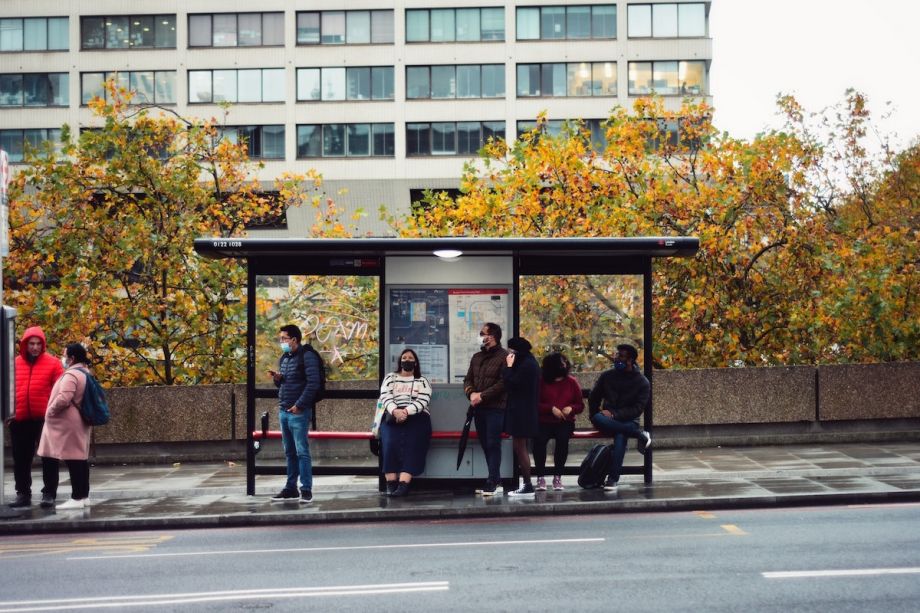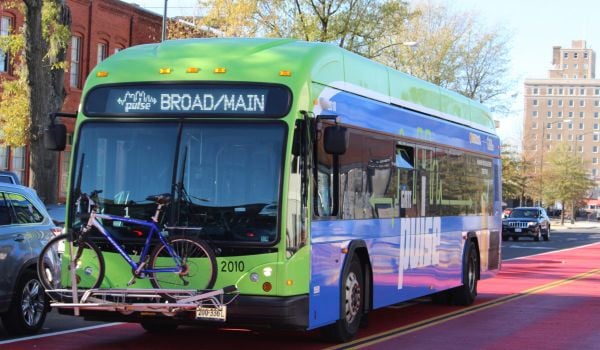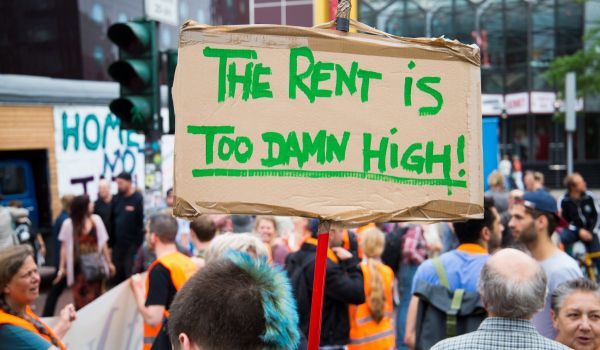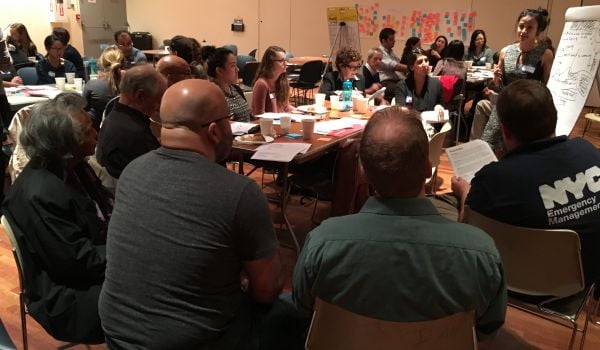This story was originally published by The Virginia Mercury.
Shortly after Chesterfield County poured a concrete pad to support a new bus shelter along Route 1, the Virginia Department of Transportation told local officials they would have to rip it out. The six inch deep pad may be standard for transit agencies across the country, but regulations developed by the Department of General Services (DGS) treat bus shelters with the same seriousness of a house and mandate an 18” deep foundation, a cost-prohibitive requirement for Virginia’s cash-strapped transit providers.
Although the Department of Rail and Public Transportation (DRPT) was able to broker an agreement to prevent the Chesterfield pad’s removal, the Kafkaesque bureaucratic barriers to installing essential transit infrastructure on state right-of-ways remain. Can Virginia officials come together and remove the red tape blocking more bus shelters?
Byzantine bus shelters
With 15,041 bus stops across the commonwealth, the problem is potentially huge.
Under Virginia’s unique system of localities, independent cities and towns retain control over their roads and bear the burden of maintaining them. Counties do not and must rely upon VDOT. Many of the most transit-rich parts of Virginia are cities like Norfolk and Richmond that rule their own right-of-way; suburban sprawl, however, has expanded the demand for transit into areas totally under VDOT’s oversight such as Fairfax and Loudon Counties.
Projections included in DRPT’s 2022 Transit Equity & Modernization Study estimate that across the commonwealth just 11% of bus stops have a shelter, 19% have a bench, and only 38% fully comply with the Americans with Disabilities Act. Two bills this year introduced by Richmond lawmakers Del. Delores McQuinn and then-Sen. Jennifer McClellan may expand the state’s Transit Rider Incentive Program to allow up to 30% of its annual grant funding to go toward bus stop infrastructure. This means there may be a new source of dollars to make improvements.
Before a concrete pad, bench or shelter can be installed on the state right-of-way, two Virginia agencies must sign off. VDOT must grant permission for the space to be used, and DGS must sign off on the proposed structure. The full process necessitates collaboration between transit agencies, localities, the manufacturer of the shelter, VDOT, DGS, and potentially any architectural review boards in the area.
Asking understaffed localities and transit agencies to navigate such a Byzantine process often means that essential transit infrastructure like sidewalks and bus shelters never get installed. Without the assistance of engineers from DRPT to negotiate with VDOT and DGS, Chesterfield’s planned shelter along Route 1 likely never would have been permitted.
“Because we are a county agency, we are not well-versed on a lot of the state procedures,” said J. Elias O’Neal, a public information officer with Chesterfield. “We were concerned that we were going to have to rip them out, but DRPT has really stepped in and helped us.”
Wackadoodle work
In Albemarle County, board of supervisors member Diantha McKeel has had no such luck. After four years of fighting VDOT for essential transit infrastructure along roadways in her district, Albemarle has only been able to add one bus shelter. Intended to be something of a prototype, the shelter at the Stonefield shopping center happened only because it is located on private property, McKeel said.
As a founding member of Charlottesville’s Regional Transit Partnership, McKeel is “very aware that citizens do not have safe transit away from the elements, the rain, the snow.” Instead, according to her, “Really they just have poles in the ground, and a lot of [Charlottesville Area Transit] stops don’t even have a concrete pad much less ADA accessibility. You don’t feel very safe standing out on the road with a pole.”
McKeel estimates there are as many as 60 bus stops in Albemarle County that could benefit from essential transit infrastructure like sidewalks, benches, and shelters. She is advocating for state installation guidance that is “targeted, simple, and not bureaucratic.”
When Albemarle officials first began negotiating with VDOT over bus shelters, McKeel was informed that every single proposed bus shelter location would have to be approved and renewed annually. Her reaction?
“That is wackadoodle,” said McKeel. “Do they not understand the enormity of what that would require in terms of staff time to review and renew each one of our proposed bus stops annually?”
As the widow of a husband who worked for VDOT for 41 years, McKeel has great respect for the agency’s work, even if she can’t understand why they have not better adjusted to Virginia’s rapidly growing, urbanized communities.
“That bureaucracy has got to figure out how to work within the constraints we have within urbanized areas and not make this difficult,” she said. “Getting a bus shelter shouldn’t be rocket science. Think of the irony of having a department of transportation where we can’t figure out how to transport people safely with protection from the weather. They ought to be embracing our work around transit and making it easier for us.”
A streamlined solution?
After Albemarle County alerted DRPT to the problem a year and a half ago, agency officials have been digging into what they could do to map out the VDOT and DGS process, remove red tape, and shepherd essential infrastructure projects through.
“Understanding that both DGS and VDOT have code requirements that they have to fulfill, we can help with the communication and education, and that will go a long way to making the process work smoother,” said DRPT director Jennifer DeBruhl. “Here we are 100% committed to facilitating these improvements as much as we can so we can better care for the riders of our transit systems around the commonwealth.”
Although negotiations are still underway to produce a more streamlined bus shelter approval process for state right-of-ways, DRPT has crafted a written guide for localities and transit providers outlining the process and necessary approvals. Has the document helped?
“Absolutely,” according to Chesterfield County’s O’Neal. “That’s how we’ve been able to provide those amenities along that route. And it has prevented us from having to rip any of them up.”
Going forward DRPT has asked localities and transit providers across the commonwealth to work through them so that the agency can assist with submittals to both VDOT and DGS. For smaller, rural communities that lack the resources to navigate such complex approvals, DRPT is also providing procurement support and engineering assistance.
If VDOT and DGS can agree on a set of standard shelter choices, then statewide procurement processes could offer a selection of pre-approved shelters that DRPT might have under contract or purchase on behalf of transit providers to further accelerate deployment.
For DeBruhl, all of these accommodations boil down to providing customers with top-notch transit service across Virginia in line with the recommendations of the 2022 modernization study.
“One of the findings was there is a need, from a safety and accessibility perspective, to have more infrastructure to support all of our transit riders but especially our transit-dependent populations that rely on our services to help get them to jobs, education, and healthcare everyday,” she said.

Wyatt Gordon is a born-and-raised Richmonder with a master’s in urban planning from the University of Hawai‘i at Mānoa and a bachelor’s in international political economy from the American University in Washington, D.C. He currently covers transportation, housing, and land use for the Virginia Mercury. He also works as a policy and campaigns manager for land use and transportation at the Virginia Conservation Network. Wyatt is a proud Northsider you can find walking, biking, and taking the bus all over town.
















